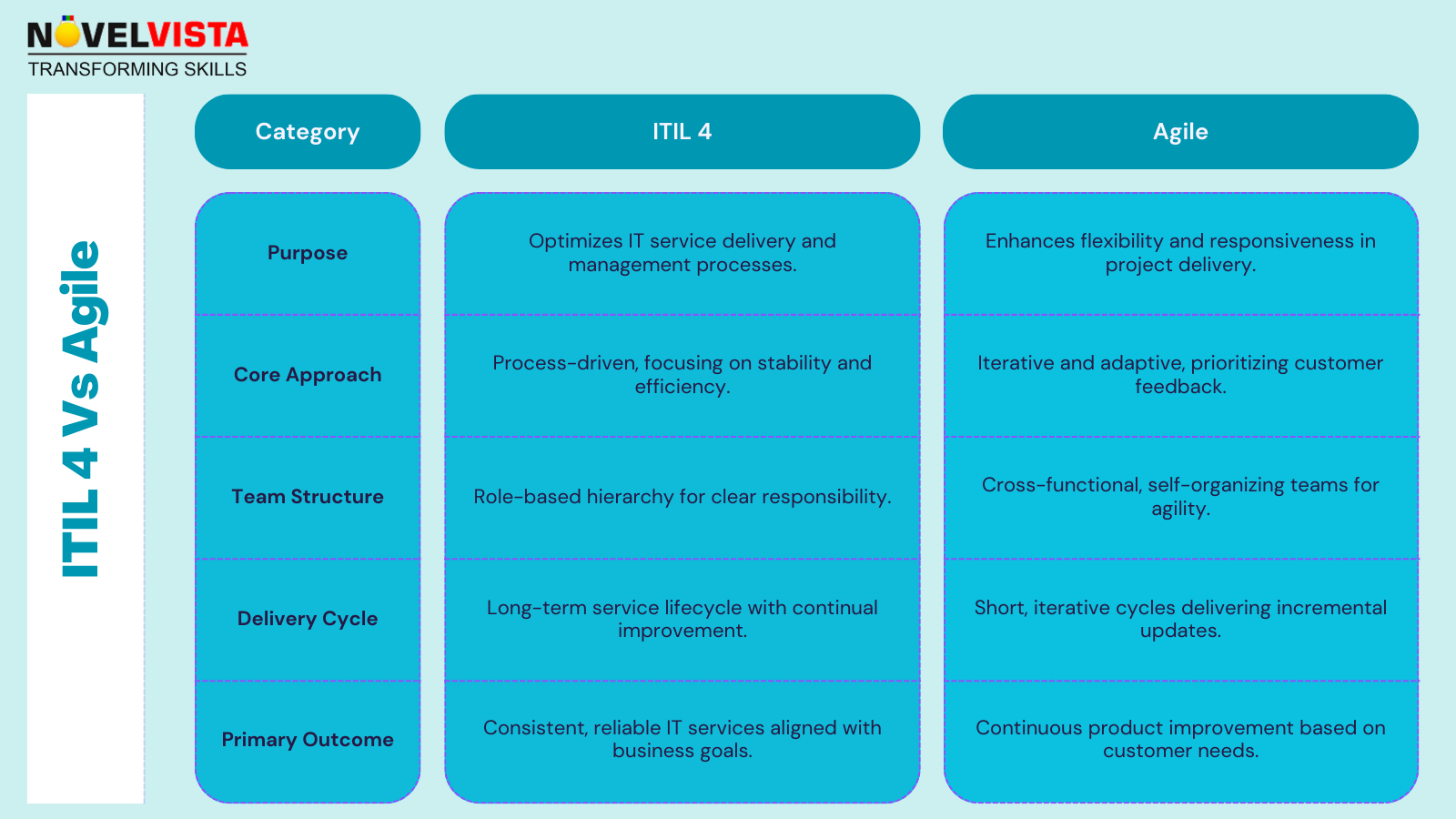Enroll Now and Get Upto 30% Off
* Your personal details are for internal use only and will remain confidential.

Last updated 20/11/2024

A new trend in IT Service Management (ITSM) is combining ITIL 4 and Agile methods. This is a positive step forward for managing IT services. They are both for improving service delivery and customer satisfaction, but they are rooted in two different philosophical approaches.
ITIL is a framework for service management, and, on the other hand, Agile focuses on deploying fast practice launches with flexible structures.
Together the frameworks generate a process synergy that can result in better operational processes, better interaction with customers, as well as more flexible approaches towards service management.
Common Goals: Both models of ITIL 4 and Agile are concerned with value creation and customer satisfaction. Nevertheless, Agile includes flexibility to customer’s needs, and ITIL describes the structure of service management in detail. Combining these strategies strengthens systematic business processes while leaving room for agile adjustments.
Enhanced Workflow: The defined nature of ITIL, implemented within the context of Agile’s cyclical processes, enhances incident and problem management. Facilitating this integration enables organizations to address common bottlenecks and optimize the flow and efficiency of service delivery. For example, the ITIL problem management process may be complemented by the Agile approach to continuously develop solutions and receive feedback.
Customer Involvement: Agile emphasizes customer collaboration throughout the service development and management process. When paired with ITIL’s service management guidelines, teams can engage customers early in the process to co-design solutions that meet real needs. This collaborative approach ensures services remain aligned with user expectations and fosters stronger relationships.
Iterative Releases: Agile promotes the concept of delivering minimum viable solutions and refining them over time based on user feedback. By integrating this principle into ITIL’s continual improvement process, organizations can release service updates in manageable phases. This enables rapid adjustments to changing requirements and ensures that services evolve with customer needs.
Feedback Loops: One of the key benefits of Agile is its focus on continuous feedback. Regular feedback loops enable teams to refine processes and services incrementally. Integrating these loops within ITIL’s structured practices allows organizations to ensure that service offerings are continuously improved based on real user input.
Agile Mindset: Adopting an Agile mindset involves prioritizing collaboration, responsiveness, and simplicity. Teams are encouraged by this mentality to adopt a more flexible and comprehensive approach in place of strict, isolated procedures. When applied within ITIL’s service management framework, this can lead to enhanced responsiveness and better service outcomes.
For ITIL 4 and Agile to be integrated, there is a need to look at the fundamental basics of both frameworks. Since ITIL 4 is based on several guiding principles such as focusing on value, starting where you are, and progressing iteratively with feedback, ITIL 4 well complements Agile, which also works on the principles of collaboration with the customer and iterative development.
Knowing these similarities allows time for discovering the points of intersection and maximal cooperation.
Evaluating existing ITSM practices through the lens of both ITIL and Agile methodologies helps organizations identify strengths, weaknesses, and opportunities for improvement.
This assessment should include a review of current workflows, process efficiencies, and areas where customer input is either underutilized or could be enhanced.
A clear understanding of the current state provides a solid foundation for designing a cohesive, integrated approach.
Establishing clear objectives is essential for the successful integration of Agile with ITIL. Objectives can include improved service delivery times, enhanced customer satisfaction, and greater flexibility in responding to business needs.
Setting specific, measurable goals enables teams to focus their efforts and track progress over time.
Equipping teams with knowledge and skills in both ITIL 4 and Agile practices is an important component of integration.
Investing in training programs that cover the principles and practical applications of each framework ensures that team members can navigate the complexities of an integrated approach.
Training should include workshops, certification programs, and on-the-job coaching to reinforce learning.

ABC Corporation is a perfect example of an organization that leveraged ITIL 4 and Agile to increase the performance of various processes in the organization.
By creating cross-functional teams and using Scrum/Kanban, key approaches were developed within ABC Corporation's organization, and each team became accountable for the complete delivery of services.
Such integration led to a 30% decrease in project lead time and a 20% improvement in customer satisfaction scores. Iterative releases promoted fast change as a result of feedback received by the service delivery teams.
Wipro Limited’s approach to integrating ITIL 4 with Agile proved particularly beneficial during the COVID-19 pandemic.
Faced with rapidly changing customer needs and remote work challenges, Wipro applied ITIL 4’s service value system alongside Agile practices to maintain seamless service delivery.
This combination allowed the company to respond quickly to new requirements and maintain high levels of customer satisfaction during an unpredictable period.
Global Tech Solutions, a multinational IT service provider, adopted an integrated ITIL-Agile framework to enhance its service management processes across various regions.
Combining ITIL’s incident management and problem-solving structures with Agile’s sprint-based iterative work cycles allowed teams to prioritize critical incidents swiftly and implement improvements based on rapid feedback loops.
The organization saw a 40% reduction in downtime and faster incident resolution times. Employees reported increased engagement and collaboration due to shared ownership of service outcomes.
Resistance to Change: Resistance to change can be a significant barrier. Leadership should ensure clear communication of integration goals and provide constant training and technical assistance to ease the transition.
Balancing Structure and Flexibility: Conflicts between ITIL's structure and Agile's flexibility can arise. Regular reviews and retrospective meetings can help maintain balance and align processes with business goals.
Tool and Technology Alignment: Organizations may need to enhance or adapt ITSM tools to support both frameworks effectively. Synchronization and data exchange are essential for seamless integration.
When ITIL 4 is integrated with Agile practices, IT Service Management can be significantly strengthened. ITIL provides a sound framework of governance, while Agile encourages innovation. Together, they offer a balance of governance and flexibility, enabling organizations to deliver superior services.
In a rapidly changing digital environment, the integration of ITIL 4 and Agile frameworks is essential for staying competitive and responsive to evolving market needs.
Topic Related PostVikas is an Accredited SIAM, ITIL 4 Master, PRINCE2 Agile, DevOps, and ITAM Trainer with more than 20 years of industry experience currently working with NovelVista as Principal Consultant.
* Your personal details are for internal use only and will remain confidential.